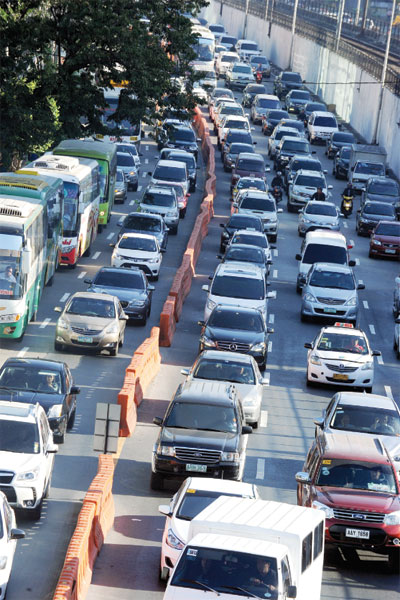Bilateral initiatives to target infrastructure
Updated: 2016-07-01 14:21
By FELIKS CHEANG(China Daily Asia)
|
|||||||||
 |
|
A major thoroughfare is clogged with traffic in Manila on Jan 11. The Philippines needs massive investment to improve its weak infrastructure which is hindering economic development. [Photo/Agencies] |
Filipinos are no strangers to traffic jams, flight delays and port congestion.
As the new Philippine government takes office, it is faced with a range of challenges to improve the country's weak infrastructure.
Nora K Terrado, undersecretary for the industry promotion group with the Philippines' Department of Trade and Industry, said this weakness has deterred many investors.
The development of infrastructure projects in the country is similar to "building the plane while it's flying", she said, and cited a local airport as an example: "It is so congested. We have three terminals but only one runway. Those are the kind of things that will take time to solve — we are so impatient."
Benjamin E Diokno, the country's new budget secretary, recently told The Inquirer newspaper that "the economy is deficient in all types of infrastructure — highways and bridges, ports and airports".
Despite fresh sources of infrastructure financing at home — such as major listings on the Philippine Stock Exchange and fresh public-private partnership deals — the country is turning to China for massive infrastructure investment.
This was especially evident last December when former president Benigno Aquino III approved the country's membership in the China-led Asian Infrastructure Investment Bank (AIIB).
"We have a big need for high-speed trains, railways, seaports and airports, and that is the expertise of China," said Wilson Lee Flores, a columnist with The Philippine Star newspaper.
He shares Terrado's opinion that demand is high for infrastructure, and it should top the agenda of President Rodrigo Duterte — who took office on June 30 — as most infrastructure projects will take from one to four years to complete.
With excessive capital and construction materials in China, Flores added that the Philippines can "benefit a lot" from cooperation with its neighbor.
Deng Jun, country head of the Bank of China's Manila Branch, said that China is a possible "white knight" for Philippine infrastructure, particularly in electricity and power equipment, which is China's comparative advantage.
"I believe Chinese companies will be able to accomplish something in this sector," he said. "And in this process, it is very important to operate by law and to find good partners."
At the AIIB's first annual meeting on June 25, China's Finance Minister Lou Jiwei affirmed that the bank differs from the Asian Development Bank (ADB), World Bank and other multilateral development banks, in having the advantage of "keener understanding of the successful experience and lessons of developing countries' years of development".
AIIB president Jin Liqun stated that the bank's specific focus on infrastructure sets it apart from others and it is committed to the concept of "international best practice".
At the meeting, the AIIB announced its first four deals, worth $509 million, including the renovation of slums in Indonesia and the construction of highways in Pakistan and Tajikistan.
A boost to the financial sector in the Philippines, and throughout the Association of Southeast Asian Nations, is expected to come from the Belt and Road Initiative, according to Wick Veloso, president and CEO for HSBC in the Philippines.
The Belt and Road seeks to build a trade and infrastructure network connecting more than 60 countries across the ancient land and maritime Silk Roads.
Business World Online noted that the initiative will help the Philippines identify opportunities to put together a more viable pipeline of infrastructure financing.
In addition to the AIIB, China created the $40 billion Silk Road Fund — which, so far, is financing a hydroelectric project in Pakistan and a liquefied natural gas project in Russia. The China Development Bank is another major source of infrastructure capital, and plans to invest $890 billion in Belt and Road projects.
Such investments are in line with China's aim to boost cooperation in production capacity and equipment manufacturing with other economies.
Regarding territorial disputes between China and the Philippines in the South China Sea, Wei Ling, director and researcher at the Institute of Asian Studies at the China Foreign Affairs University, said bilateral development is at the core of Chinese national interest and its diplomatic strategies.
She said that the Philippines can use China's successful experience in infrastructure, while such supply-and-demand cooperation can close their political gap which "has been taken to an undeserving height".
After all, "only bilateral communication can solve the problem", Wei said. She also noted that the two countries should set aside territorial disputes and "think outside the box" in exploiting green energy resources in the South China Sea.
Andrew Leung, an international China strategist, suggested that China could help improve Manila's dilapidated subway system and modernize Manila Port.
While many speculate on bilateral relations with Duterte in power, George T Siy, chairman emeritus of Association of Young Filipino-Chinese Entrepreneurs, said the time is right for China to help the Philippines to develop.
Duterte is open to inviting foreign companies to invest in infrastructure projects, he added.
The country's new finance secretary Carlos G Dominguez said that the Duterte administration can fast-track the Philippine's membership in the AIIB to widen financing options in line with plans to ramp up infrastructure development.
Today's Top News
Boris Johnson quits party leadership contest
UK parties head for leadership battles
Terrorist attack in Turkey reinforces need for unity
New British PM to be in place by Sept 9
Labour's Jeremy Corbyn loeses no-confidence vote
Poll: Migrants viewed as dividing European society
Germany, France, Italy urge Britain not to waste time in divorcing EU
Britain urged not to waste time in divorcing EU
Hot Topics
Lunar probe , China growth forecasts, Emission rules get tougher, China seen through 'colored lens', International board,
Editor's Picks

|

|

|

|

|

|







